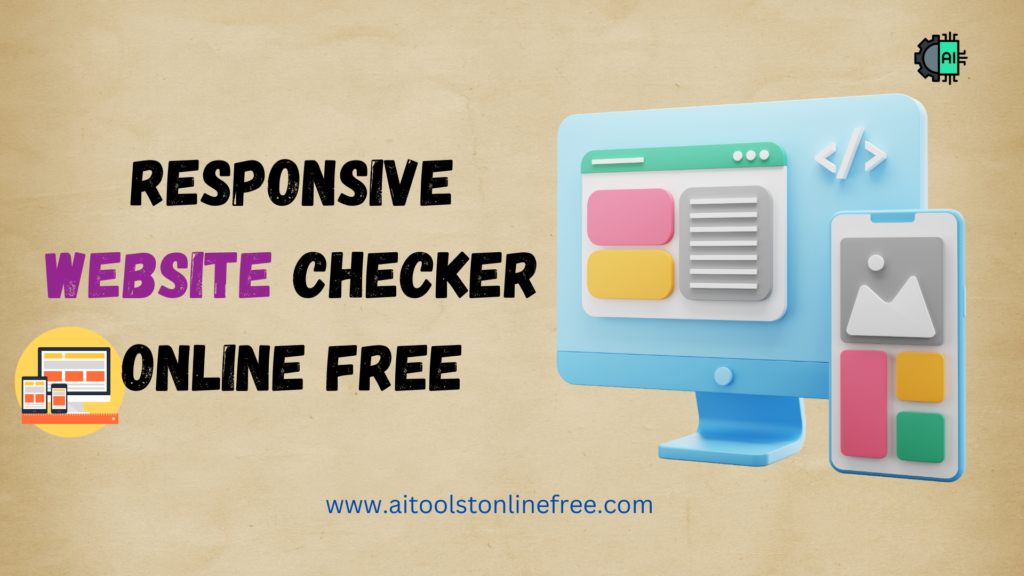Responsive Website Checker Tool
Toolkits As Per Your Needs

A Definitive Manual for Guaranteeing Your Website's Responsiveness: Utilizing a Responsive Website Checker
In the high-speed computerized scene, guaranteeing your website’s responsiveness is fundamental to success. With the rising collection of devices used for web scrutiny, from work areas to mobile phones and tablets, clients expect predictable experiences regardless of screen size. In this exhaustive article, we investigate the significance of a responsive plan and tell you the best way to use a responsive site analyzer to guarantee that your site conforms to present-day principles.
Understanding Responsive Design
In the time of mobile-first ordering via search engines like Google, responsive design has turned into a key part of web development. Responsive design permits websites to adjust and give ideal client encounters across different gadgets and screen sizes. From adaptable formats to liquid pictures and media questions, the responsive design guarantees that content delivers accurate and consistent capabilities no matter what gadget is utilized.
Significance of Website Responsiveness
A responsive website isn’t just about style; it straightforwardly influences client commitment, maintenance, and, eventually, change rates. Studies have shown that clients are bound to leave websites that perform poorly on their gadgets. Also, search engines focus on mobile-friendly websites in their rankings, making website responsiveness significant for SEO (Search Engine Advancement) and permeability.
Utilizing the Tool: Bit by bit Guide
- Enter Website URL: In the designated field, begin by entering the URL of the website you need to investigate.
- Select Gadget: Pick the gadget type you wish to recreate – desktop, tablet, or mobile.
- Create Report: Snap the “Check” button to start the examination interaction.
- Audit Results: Investigate the report produced, which might incorporate measurements such as page load times, viewport changes, and visual delivery across gadgets.
- Improve: In light of the discoveries, upgrade your website’s design and usefulness to upgrade responsiveness.
Advantages of Utilizing a Responsive Website Checker
- Improved Client Experience: By recognizing and tending to responsiveness issues, you can make a more pleasant and consistent perusing experience for your audience.
- Further developed SEO Performance: Search engines favour mobile-friendly websites, prompting higher rankings and expanded organic traffic.
- Diminished Bob Rates: With a responsive website, clients will remain drawn in and investigate your substance, lessening bob rates and further developing by and large transformation measurements.
- Future-Sealing: As new gadgets and screen sizes emerge, routinely testing your website’s responsiveness guarantees it will remain versatile and future-verified.
Contextual Investigations and Success Stories
Investigate how businesses and associations have utilized responsive website checkers to improve their online presence and accomplish unmistakable results. From internet business stages to corporate websites and then some, find how putting resources into responsiveness delivers profits in client satisfaction and business growth.
Conclusion
In conclusion, website responsiveness couldn’t be more significant in the present advanced scene. With clients getting to the web from a different exhibit of gadgets, guaranteeing your website performs impeccably across all stages is fundamental for success. Using a responsive website checker, you can distinguish expected issues, improve your website’s design, and convey excellent client encounters that drive commitment and transformations. Remain on the ball and focus on responsiveness – Search engines and your readers will both appreciate it.
Informative supplement: Glossary of Terms
A responsive plan is a website composition strategy that ensures site pages conform to various screen sizes and gadgets. Web optimization (Web search tool Smoothing out) is the most common way of further developing sites to appear higher on search engine crawler results pages (SERPs) and attract natural guests. Client Experience (UX) is the overall understanding of a client while interfacing with a site or application, encompassing comfort, transparency, and fulfilment.
Page Load Time is how long it takes for a webpage to load completely and show its substance to the client. This time influences client experience and SEO performance.
Popular Tools
- Age Calculator
- Word Count
- Bad & Toxic Backlink Checker
- Link Analysis Tool
- QR Code Generator
- File Downloader
- Internet Speed Test
- Secure Password Generator
- What is my IP
- Audio Recorder
- Text To Speech Converter
- Background Remover
- Screen Recording
- Image Compressor
- Image Resizer
- Drawing Canvas
- Notepad, Create Notes
- Typing Speed Test
- Pie Chart Maker
- Fancy Text Generator
- Website Speed Test
- Digital Signature
FAQ's
How to check if a website is responsive?
You can utilize a responsive site checker instrument to determine whether a site is responsive. Just type the site's URL into the apparatus, select between work area, tablet, and cell phone, and start your request. Subsequently, the tool will replicate the selected device's screen size and demonstrate how the website functions and presents on different devices.
How do I inspect responsive in Chrome?
In Google Chrome, you can undoubtedly examine the responsiveness of a website utilizing the underlying Designer Tools. To do this, right-click on the webpage you need to examine and choose "Investigate" from the settings menu. In the open Planner Devices board, click on the "Switch Contraption Toolbar" image (or press Ctrl + Shift + M), which seems to be a phone and a tablet.
How do I make my website 100% responsive?
Utilizing responsive plan rules and practices is important for making a site completely responsive. Here are a few key stages:
- Utilize a responsive design structure or CSS lattice framework to make adaptable formats that adjust to various screen sizes.
- Use media questions to apply explicit styles given the gadget's screen width, goal, and direction.
- Improve pictures and media resources for various gadgets to guarantee quick loading times and ideal performance.
- Test your website's responsiveness across different gadgets and screen sizes utilizing tools like a responsive website checker or browser engineer tools.
- Ceaselessly screen and update your website's responsiveness to oblige new gadgets and client behaviour methods.
What is the best browser to test responsive web design?
Sometimes, most present-day web browsers offer engineering tools with responsive design testing capacities; Google Chrome is considered one of the most amazing browsers for testing responsive web design. Chrome's Engineer Tools give an easy-to-use connection point for investigating and troubleshooting websites, including highlights like gadget copying, viewport resizing, and responsive design testing. Furthermore, Chrome's broad use among developers and designers makes it an optimal decision for guaranteeing cross-browser similarity and an ideal client experience.
